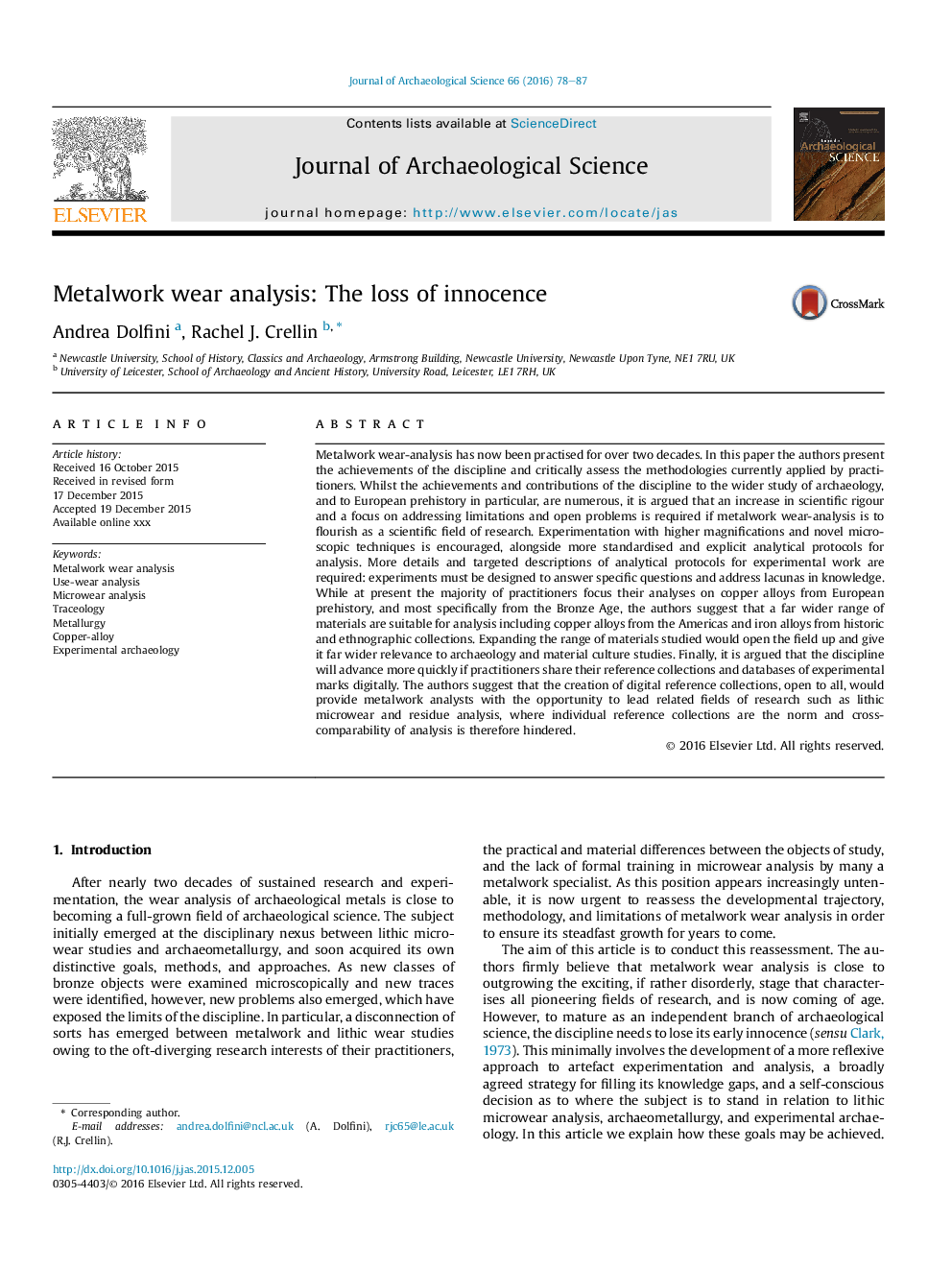| کد مقاله | کد نشریه | سال انتشار | مقاله انگلیسی | نسخه تمام متن |
|---|---|---|---|---|
| 7441555 | 1483894 | 2016 | 10 صفحه PDF | دانلود رایگان |
عنوان انگلیسی مقاله ISI
Metalwork wear analysis: The loss of innocence
ترجمه فارسی عنوان
تجزیه و تحلیل سایش فلز: از دست دادن بی گناهی
دانلود مقاله + سفارش ترجمه
دانلود مقاله ISI انگلیسی
رایگان برای ایرانیان
کلمات کلیدی
ترجمه چکیده
در حال حاضر بیش از دو دهه مورد استفاده قرار گرفته است. در این مقاله، نویسندگان دستاوردهای این رشته را ارائه می دهند و از لحاظ انتقادی روش شناسی که در حال حاضر توسط متخصصین استفاده می شود، ارزیابی می شود. در حالی که دستاوردها و مشارکت های این رشته به مطالعه گسترده تر باستان شناسی و به ویژه تاریخ پیش از تاریخ اروپا، متعدد است، استدلال می شود که افزایش سختی های علمی و تمرکز بر رسیدگی به محدودیت ها و مشکلات باز، اگر تجزیه و تحلیل فلزکاری به عنوان یک حوزه علمی تحقیقاتی شکوفا می شود. آزمایش با بزرگنمایی های بزرگ و تکنیک های میکروسکوپی جدید، همراه با پروتکل های تجزیه و تحلیل استاندارد و استاندارد تر برای تجزیه و تحلیل، تشویق می شود. جزئیات بیشتر و توصیف هدفمند از پروتکل های تحلیلی برای کار تجربی مورد نیاز است: آزمایش ها باید برای پاسخگویی به سوالات خاص و با توجه به لکون ها در دانش طراحی شوند. در حالی که در حال حاضر اکثر تمرینکنندگان تجزیه و تحلیل خود را بر روی آلیاژهای مس از پیش از تاریخ اروپا و به طور خاص از عصر برنز تمرکز می کنند، نویسندگان پیشنهاد می کنند که طیف گسترده ای از مواد برای تجزیه و تحلیل شامل آلیاژهای مس از آمریکا و آلیاژهای آهن از تاریخ و مجموعه های قوم نگاری. گسترش محدوده مواد مورد مطالعه، زمینه را باز می کند و ارتباطات گسترده ای را برای مطالعات باستان شناسی و مطالعات فرهنگی می دهد. در نهایت، استدلال می شود که اگر تمرینکنندگان مجموعه های مرجع و پایگاه های داده های تجربی خود را به صورت دیجیتالی به اشتراک بگذارند، رشته سریع تر پیشرفت خواهد کرد. نویسندگان معتقدند که ایجاد مجموعه مرجع دیجیتالی، برای همه باز است، تحلیلگران فلزکاری را با امکان دستیابی به زمینه های تحقیقاتی مرتبط مانند تجزیه و تحلیل مایکروویو های لیتیم و باقی مانده، که در آن مجموعه مرجع فردی، هنجار است و مقیاس پذیری تجزیه و تحلیل بنابراین مانع شد
موضوعات مرتبط
مهندسی و علوم پایه
مهندسی مواد
دانش مواد (عمومی)
چکیده انگلیسی
Metalwork wear-analysis has now been practised for over two decades. In this paper the authors present the achievements of the discipline and critically assess the methodologies currently applied by practitioners. Whilst the achievements and contributions of the discipline to the wider study of archaeology, and to European prehistory in particular, are numerous, it is argued that an increase in scientific rigour and a focus on addressing limitations and open problems is required if metalwork wear-analysis is to flourish as a scientific field of research. Experimentation with higher magnifications and novel microscopic techniques is encouraged, alongside more standardised and explicit analytical protocols for analysis. More details and targeted descriptions of analytical protocols for experimental work are required: experiments must be designed to answer specific questions and address lacunas in knowledge. While at present the majority of practitioners focus their analyses on copper alloys from European prehistory, and most specifically from the Bronze Age, the authors suggest that a far wider range of materials are suitable for analysis including copper alloys from the Americas and iron alloys from historic and ethnographic collections. Expanding the range of materials studied would open the field up and give it far wider relevance to archaeology and material culture studies. Finally, it is argued that the discipline will advance more quickly if practitioners share their reference collections and databases of experimental marks digitally. The authors suggest that the creation of digital reference collections, open to all, would provide metalwork analysts with the opportunity to lead related fields of research such as lithic microwear and residue analysis, where individual reference collections are the norm and cross-comparability of analysis is therefore hindered.
ناشر
Database: Elsevier - ScienceDirect (ساینس دایرکت)
Journal: Journal of Archaeological Science - Volume 66, February 2016, Pages 78-87
Journal: Journal of Archaeological Science - Volume 66, February 2016, Pages 78-87
نویسندگان
Andrea Dolfini, Rachel J. Crellin,
